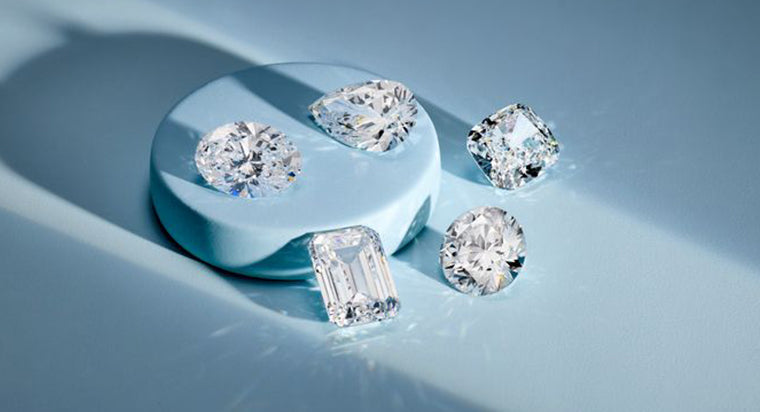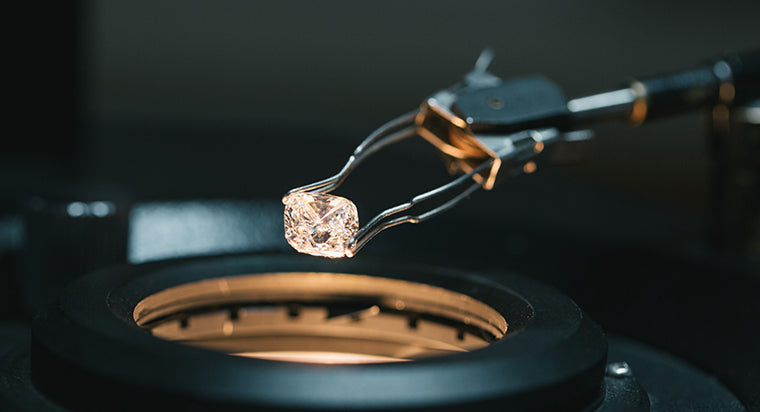What is Diamond Depth?

Diamond cut is the most crucial aspect in creating a dazzling diamond. Contrary to popular belief, cut refers not to a diamond's shape (e.g. round, oval, pear, etc.) but to a diamond's proportions, symmetry and polish. Diamond cut has three primary effects on appearance: brilliance (the brightness of reflected and refracted light), fire (the dispersion of light into flashes of visible color), and scintillation (flashes of light and dark, or sparkle, when a diamond is moved).
TABLE OF CONTENTS
Cutting a Diamond
When polishing a rough diamond, cutters must find a balance between an optimal cut (i.e. an ideal appearance) and maximum yield (i.e. retaining maximum carat weight). Because many customers prefer a larger, fair-cut cut diamond over a slightly smaller, well-cut diamond, the cutter is often pressured to sacrifice appearance for weight.
Determining Depth
Diamond depth is a crucial factor of a diamond's cut. The depth of diamond is its height (in millimeters) measured from the culet (bottom tip) to the table (flat, top surface). On a grading report, there are normally two measurements of diamond depth. The first measurement is the actual depth of diamond in millimeters. The second is the diamond depth percentage, indicating the diamond depth in relation to its width. The diamond depth percentage is calculated by dividing total depth by the average diameter, then multiplying by 100.
Light and Depth
After light enters a diamond, the diamond depth determines how much of that light reflects back up to the observer's eye. If the diamond depth is too shallow, the light strikes the pavilion facet at a low angle and passes through the facet, escaping through the bottom of the diamond. If the diamond depth is too deep, the entering light reflects off the first pavilion facet but strikes the second pavilion at too low an angle, causing the light to refract, escaping through the bottom of the diamond. A diamond with an ideal diamond depth will allow the light to strike each pavilion facet at an angle which allows most of the light to reflect back to the top.
Table and Depth
Diamond depth and table are two crucial factors in creating a magnificent diamond. A diamond's table refers to the flat facet of the diamond which can be seen when the stone is face up. As the largest facet on a diamond, a diamond’s table plays a vital role in creating the diamond’s brilliance by refracting entering light rays and allowing reflected light rays back into the observer's eye.
Diamond Table and Depth
| Shape | Ideal Table % | Depth % |
|---|---|---|
| Round | 53-58 | 59-62.3 |
| Oval | 53-63 | 58-62 |
| Emerald | 61-69 | 61-67 |
| Princess | 67-72 | 64-75 |
| Asscher | 61-69 | 61-67 |
| Pear | 53-63 | 58-62 |
| Marquise | 53-63 | 58-62 |
| Radiant | 61-69 | 61-67 |
| Cushion | 61-67 | 61-67 |
| Heart | 53-63 | 58-62 |
Table Percentage
Similar to the diamond depth percentage, a diamond's table percentage is calculated by dividing the diameter of the table by the average diameter of the girdle. For fancy shaped diamonds, table percentage is computed by dividing the table width by the width of the widest part of the stone.
Ideal Round Diamonds
The ideal diamond table and depth percentage depends on the shape of the diamond. For example, the best table and depth for round diamonds is a depth percentage between 62.9 and 59.5 percent and a table percentage between 63 and 56 percent. The best depth for diamonds with a princess cut is between 64 and 75 percent while its ideal table percentage is between 67 and 72 percent. For oval diamonds, the ideal diamond depth is between 58 and 62 percent while the ideal table percentage is between 53 and 63 percent.
Diamond Cut Grading
Diamond table and depth affect a diamond's overall cut grade. Of all a diamond's 4 Cs, cut is the most complex and technically difficult to analyze. In order to grade cut, laboratories calculate the proportions of the facets that influence the diamond's face-up appearance, thus evaluating how successfully a diamond interacts with light to create brightness, fire, and scintillation—all aspects of a diamond’s signature brilliance. A diamond’s cut grade also considers the design and craftsmanship of the diamond, including its weight relative to its diameter, its girdle thickness, symmetry of facet arrangement, and the polish quality.
From there, the diamond's cut is graded on a scale, often differing by the laboratory performing the diamond grading. The Gemological Institute of America and European Gemological Laboratory classify diamond cut on a scale comprised of the categories Excellent, Very Good, Good, Fair, and Poor while the American Gem Society uses a numerical scale from zero to ten.
Because a diamond's cut is the best place to start when selecting the perfect diamond, take the time to research the ideal cut for your desired diamond shape.
FAQs
What is the difference between diamond depth and table?
What is a good depth for a round diamond?
How to calculate the depth percentage of a round diamond?
What is a good depth for an oval diamond?









